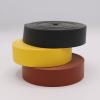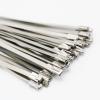How to not order the wrong size
Heat shrink tubing, by definition, comes with a circular cross-section. That’s what a tube is after all — just a cylinder, which itself is a circle that’s been extruded (or stretched) over a particular length.
The great thing about a circle is that every point on the surface is exactly the same distance from the center. That’s the definition of a circle, after all, and that distance is known as the radius. If there is more than one radial distance, then you no longer have a circle, you have at least an ellipse, but that’s a completely different animal.
If you’re dealing with putting a circle around a circle, then life is easy. The smaller circle goes inside the bigger one, and you’re done.
Square peg in a round hole
So you have tubular heat shrink and you have a cylindrical wire or wires you want to put it around. Great. All you need to know is the diameter of all the wires together and the final diameter of the heat shrink after it’s been shrunk. The diameter of any circle — the straight-line distance through the center from one side to the other — is simply two times the radius, frequently written as 2r.
But what if you need to wrap a different shape, like something with a square cross-section? It’s easy to make the mistake of thinking, “Okay, I want to shrink-wrap a 1” square, so I need heat shrink with a final diameter of 1” as well.”
If you do that, you’re going to wind up with tubing too small for your needs. That all has to do with geometry. When the side of a square and the diameter of a circle are equal, the greatest width of the square is actually going to be more than the diameter of the circle.
Fun with geometry
That’s all thanks to the Pythagorean theorem, which you might remember explaining that, in a right triangle, A2 + B2 = C2, where A and B are the sides forming the right angle and C is the long side opposite, called the hypotenuse.
The details of it aren’t important right now. What matters is that it’s pretty obvious that C must be greater than A or B.
A quick and easy example: If a right triangle has sides with lengths of A=3 and B=4 inches, then the squares of those lengths are 9 and 16. Add those together and you get 25, which is C2. The square root of 25 is 5, which is greater than either of the other numbers.
To make it even clearer, let’s make A and B both equal to 1. The sum of 1 squared and 1 squared is 2. The square root of 2 is approximately 1.414 — which is an irrational number, more on which below.
But what this basically means is that no matter what value of A and B you start with, whatever C squared you derive from them will always be bigger than each of them.
But if A and B are equal and you put those two right triangles together on the long side C, what do you get? A square. And the widest point of that square is not along any side. It’s along that diagonal in the middle, C. So if you have a square with sides equal to the diameter of a circle, that circle is going to fit inside of the square every single time.
That’s why, in order to use cylindrical heat shrink tubing on a square object, you need to figure out the flat width of that tubing, and this is where another bit of math and geometry comes into play. Don’t worry: This won’t be as scary as it might sound. Working the numbers is really quite easy, even if you fully don’t get the “why.”
Easy as pi
The important number we need to know is the circumference of the circle, which is the distance all the way around the outside. We have a constant to represent that distance, and it’s a very famous term known as “pi,” symbolized by the Greek letter π.
So what is the circumference of a circle? Mathematically, you can calculate it as 2πr, which is also equal to just pi times the diameter, πD. If you happen to have a circle with a diameter of 1, then the circumference is pi, so we know exactly what that distance is now, right?
Wrong. Nobody knows exactly what the circumference is. That’s because pi, like the square root of 2, is considered to be an irrational number, as far as we know. An irrational number is one that never repeats a series of digits and never comes to an end, no matter how many digits you calculate to.
For example, a fraction like 1/3 is a rational number because it works out to 0.333... with the 3s repeating forever. So far, pi has been calculated to 31 trillion digits with neither end nor repeating sequence anywhere in sight yet, meaning that we probably never will find either.
Incidentally, you might be wondering how they figured out Pi in the first place, since we need it to get the circumference of a circle. You can read all about it if you’d like, but the short version is that it involved right triangles again. Archimedes simply created a square that fit just inside of a circle, then one that the circle just fit inside of, using the Pythagorean theorem to calculate the difference in area of the squares, which gave him the upper and lower limits.
He came up with between 3 1/7 and 3 10/71, both of which are equal to around 3.14, which is pretty accurate to two digits. (Today, we know pi to five digits to be 3.14159.)
Is that your final answer?
So... now we know the very approximate circumference of the circle. How do we calculate the flat width? Well, the answer is: You flatten it. That may sound facetious, but it actually works. If you flatten that circle, you wind up with a line that’s longer than the original diameter but also equal to half of the circumference.
How are the circumference and diameter related again? It’s back to pi. If πD equals the circumference, dividing this figure by two will give you the flat width. But there’s an easier way.
Get rid of pi and just look at the diameter, which you already know. Then either divide the diameter by 0.637 or multiply it by 1.571, whichever is easier for you, and you’ll have your answer.
In the case of a 1-inch square, then, you’d need to get heat shrink tubing with a final diameter of 1.571 inches instead of just 1 inch, for example. Otherwise, you’ll find the job to be like trying to put skinny jeans on an elephant: An impossible task, and it just annoys the elephant.
Next up: We’ll look at how to figure out what the right diameter is, based on your specific needs.








